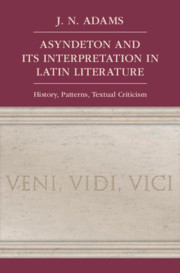Book contents
- Asyndeton and its Interpretation in Latin Literature
- Frontispiece
- Asyndeton and its Interpretation in Latin Literature
- Copyright page
- Contents
- Preface
- Acknowledgements
- Abbreviations
- Part 1 Introduction
- Part 2 ‘Grammatical’ Types
- Chapter VI Asyndetic Pairs (Mainly of Adjectives) of Which at Least One Member Is a Term with a Negative Prefix (in Latin, Usually in-)
- Chapter VII Simplex + Compound in Asyndeton
- Chapter VIII Juxtaposition of Active and Passive Forms of the Same Verb
- Chapter IX Asyndetic Pairs of Verbs of Different Tense or Mood
- Chapter X Pairs of Imperatives
- Chapter XI Masculine + Feminine Pairs
- Chapter XII Recapitulation: ‘Grammatical’ Types and Their Distribution
- Part 3 Semantic Types
- Part 4 Structures
- Part 5 Genres And Texts
- Part 6 Conclusions
- Bibliography
- Subject Index
- Index Mainly of Selected Pairs and Longer Sequences
- Selective Index Locorum
Chapter VIII - Juxtaposition of Active and Passive Forms of the Same Verb
from Part 2 - ‘Grammatical’ Types
Published online by Cambridge University Press: 13 May 2021
- Asyndeton and its Interpretation in Latin Literature
- Frontispiece
- Asyndeton and its Interpretation in Latin Literature
- Copyright page
- Contents
- Preface
- Acknowledgements
- Abbreviations
- Part 1 Introduction
- Part 2 ‘Grammatical’ Types
- Chapter VI Asyndetic Pairs (Mainly of Adjectives) of Which at Least One Member Is a Term with a Negative Prefix (in Latin, Usually in-)
- Chapter VII Simplex + Compound in Asyndeton
- Chapter VIII Juxtaposition of Active and Passive Forms of the Same Verb
- Chapter IX Asyndetic Pairs of Verbs of Different Tense or Mood
- Chapter X Pairs of Imperatives
- Chapter XI Masculine + Feminine Pairs
- Chapter XII Recapitulation: ‘Grammatical’ Types and Their Distribution
- Part 3 Semantic Types
- Part 4 Structures
- Part 5 Genres And Texts
- Part 6 Conclusions
- Bibliography
- Subject Index
- Index Mainly of Selected Pairs and Longer Sequences
- Selective Index Locorum
Summary
Asyndeton with an active verb form alongside a passive form of the same verb is rare in Latin. Just five clear-cut (single-word) instances have been noted, as far as I am aware, and to these may be added a slightly extended pair in Tacitus (see the next paragraph but one). Pairings of active and passive forms are more common when there is a coordinator (see Wills 1996: 295–8 for an extensive but mixed collection of material mostly from poetry, a good deal of it comprising not coordinations but actives and passives near each other in different types of clauses; for the coordinated type note e.g. Tac. Ann. 3.55.2 plebem socios regna colere et coli licitum). Wills states (296) that ‘the combination of voices in a “bimembre asyndeton” was possibly idiomatic’, a view that is at variance with the evidence, given that such pairs almost always have a coordinator. It will also be seen below that the few asyndetic examples are not a single type, such that the term ‘idiomatic’ might be appropriate.
- Type
- Chapter
- Information
- Asyndeton and its Interpretation in Latin LiteratureHistory, Patterns, Textual Criticism, pp. 121 - 124Publisher: Cambridge University PressPrint publication year: 2021



